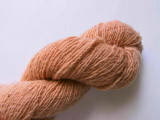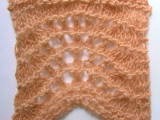


Yarn Profile: Morehouse Farm Merino First Impressions
Then I discovered that the yarn I'd so confidently criticized was from Morehouse Farm Merino, a gorgeous farm profiled in both Knitting in America and Sweaters from New England Sheep Farms. Humbly corrected, I snatched up a skein and started swatching. Knitting Up
While many commercial manufacturers use harsh processing to tame the fibers, Morehouse Farm Merino yarns undergo a minimum of processing. The yarn retains a wonderfully raw softness and bounce. While I initially thought the yarn had been overspun, I quickly discovered that the often kinked-up spin balanced itself out as soon as I began knitting under a normal tension. The extremely elastic yarn made lace knitting a breeze, stretching to accommodate just about anything my needles wanted to do. Since lace knitting often requires a lot of needle gymnastics, this elasticity is desirable. Stitches appeared relatively smooth and even, with just a hint of irregularity caused by the yarn's somewhat raw nature. Blocking / Washing
This lace-weight yarn, with its short merino fibers and gently spun single ply, provides an ideal example of the bloom phenomenon. I washed the swatches in lukewarm water with gentle soap and moderate agitation. After squeezing them dry and blotting them with a towel, I laid them out for blocking and was astonished at how much they had changed. Like uncooked pasta, the original yarn gives very little indication of just how beautiful the end results will be. The bloom gave my stitches an attractive, almost pearl-like glow. Wearing
Because of its shorter, delicate fibers, this one-ply yarn is more likely to wear out than its non-merino counterparts. From a lace perspective, this poses little problem since one tends not to wear lace while playing football or rugby. The bloom helps conceal snags and—yes, I'm afraid it's true—the inevitable pills that will emerge over time. Still, I can see a Morehouse Farm Merino lace scarf or shawl being passed down from generation to generation. Conclusion
Morehouse Farm Merino is one of the largest purebred merino sheep farms in North America, yet the personal touch remains. When you pick up a skein and hold it in your hands, you can still feel the homegrown pride. No, the yarn isn't available in glamorous packaging or psychedelic novelty textures. The presentation is simple and classic. But if you're looking for quality essential ingredients—like fresh-picked strawberries at a roadside farm stand—you're sure to enjoy Morehouse Farm Merino. |
Yarn name
Morehouse Farm Merino Lace-Weight Yarn
Manufacturer
Morehouse Farm Merino
Fiber content
100% merino wool
Gauge
6 to 8 stitches per inch on US 1 to 3 needle
Average retail
price
$8.00 / skein
Where to Buy Online
The Morehouse Farm Merino
Weight/Yardage per Skein
1 oz. / 220 yards
Country of Origin
USA
Manufacturer's
suggested wash method
Hand wash in warm water, lay flat to dry.
Review date
7/25/02 |


